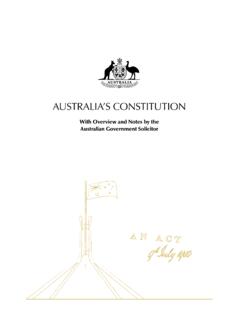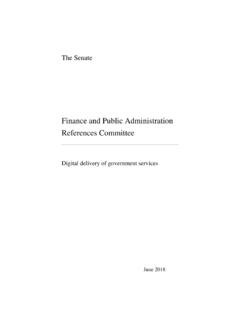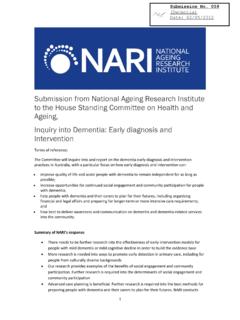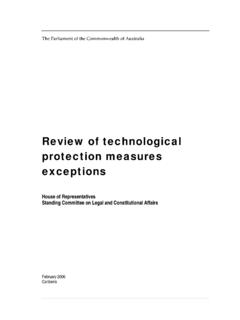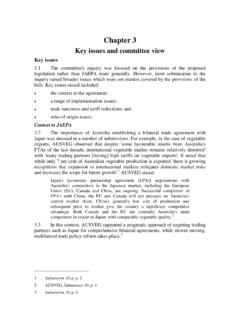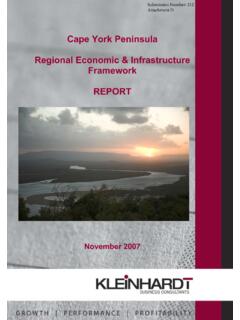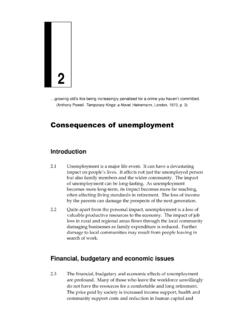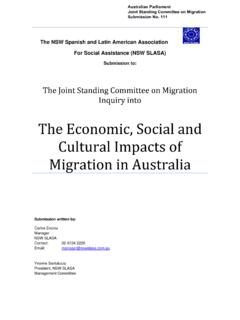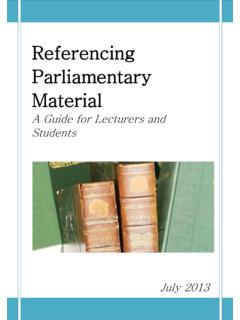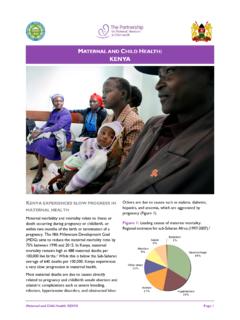Transcription of Asylum seekers and refugees: what are the facts?
1 Parliament of Australia Department of Parliamentary Services BACKGROUND NOTE Updated 14 January 2011. Asylum seekers and refugees: what are the facts? Janet Phillips Social Policy Section Contents Introduction .. 1. What is the difference between an Asylum seeker and a refugee? .. 2. Are Asylum seekers illegals'? .. 2. Are Asylum seekers queue jumpers'? .. 4. Do most Asylum seekers arrive by boat? .. 6. Do boat arrivals bring disease' and are they a threat to security? .. 7. Are boat arrivals genuine refugees'? .. 8. Do boat arrivals take all Australia's refugee places'? .. 9. Do refugees receive higher welfare benefits than Australians? .. 10. Is Australia being swamped by boat arrivals'?.. 11. Is Australia being swamped with Asylum claims'? .. 11. Do developed countries bear the burden of hosting Asylum seekers and refugees? .. 12. Summary .. 13.
2 Key resources .. 14. Acknowledgements The author is grateful to colleagues Elibritt Karlsen and Luke Buckmaster for their valuable input into this paper. Asylum seekers and refugees: what are the facts? Introduction The magnitude and complexity of the issues arising from the flow of Asylum seekers and refugees globally poses huge challenges for the world's destination countries, including Australia. These countries universally struggle to maintain a balance between controlling national borders and offering protection to millions of displaced people. When the Office of the United Nations High Commissioner for Refugees (UNHCR) was established in 1951, there were approximately million refugees internationally. 1 At the end of 2009 there were an estimated million forcibly displaced people worldwide, including million refugees, 983 000 Asylum seekers and million internally displaced persons (IDPs).
3 It is estimated that there were an additional 25 million people displaced due to natural disasters. 2. The Australian Government has recognised the magnitude of these global trends noting that the numbers of people seeking Asylum in Australia are small compared to those seeking Asylum in Europe and other parts of the world. 3. Australia has a long history of accepting refugees for resettlement and over 700 000 refugees and displaced persons, including thousands during and immediately after World War II, have settled in Australia since 1945. 4 However, despite this long term commitment, there is a great deal of confusion and misinformation in the public debate in Australia particularly around the terms Asylum seekers , refugees, illegals', queue jumpers' and boat people' which are often used interchangeably and/or incorrectly. 1. D McMaster, Asylum seekers : Australia's response to refugees, Melbourne University Press, Melbourne, 2001, p.
4 9. 2. United Nations High Commission for Refugees (UNHCR), 2009 Global trends, Geneva, June 2010, p. 1, viewed 15. December 2010, The UNHCR collects statistics for several population categories collectively referred to as persons of concern': Refugees: individuals recognised under the 1951. Convention relating to the Status of Refugees; its 1967 Protocol; the 1969 OAU Convention Governing the Specific Aspects of Refugee Problems in Africa; those recognised in accordance with the UNHCR Statute; individuals granted complementary forms of protection; or, those enjoying temporary protection'. The refugee population includes people in a refugee like situation. Asylum seekers : individuals who have sought international protection and whose claims for refugee status have not yet been determined. Internally displaced persons: people or groups of individuals who have been forced to leave their homes or places of habitual residence, in particular as a result of, or in order to avoid the effects of armed conflict, situations of generalised violence, violations of human rights or natural, or human made disasters, and who have not crossed an international border, UNHCR, 2008 Global trends, Geneva, June 2009, pp.
5 3 6, viewed 15 December 2010, 3. Former Minister for Immigration and Citizenship, Senator Chris Evans is reported to have acknowledged that the 4750 people seeking Asylum in Australia in 2008 was relatively small in global terms'. See C Evans (Minister for Immigration and Citizenship), UNHCR report confirms worldwide increase in Asylum seekers , media release, Canberra, 17 June 2009, viewed 19 April 2010, releases/2009 and in one of her first speeches as Prime Minister Julia Gillard acknowledged that in 2009 Australia only received per cent of the world's Asylum seekers ; see J Gillard (Prime Minister), Moving Australia forward: address to the Lowy Institute', Sydney, 6 July 2010, viewed 15 December 2010, ;query=Id%3A%22media%2 Fpressrel%2 FIE8X6%22. 4. Department of Immigration and Citizenship (DIAC), Key facts in immigration, fact sheet no. 2, DIAC website, viewed 15 December 2010, 1.
6 Asylum seekers and refugees: what are the facts? The purpose of this background note is to present information (in a simplified format) that may help address some of the popular misconceptions that surround Asylum issues. It includes information on Asylum claims, unauthorised arrivals and irregular migration in Australia and Europe. What is the difference between an Asylum seeker and a refugee? There is a great deal of confusion about the difference between an Asylum seeker and a refugee and often the terms are used interchangeably or incorrectly. An Asylum seeker is someone who is seeking international protection but whose claim for refugee status has not yet been determined. In contrast, a refugee is someone who has been recognised under the 1951 Convention relating to the status of refugees to be a refugee. The Convention defines a refugee' as any person who: owing to well founded fear of being persecuted for reasons of race, religion, nationality, membership of a particular social group or political opinion, is outside the country of his nationality and is unable or, owing to such fear, is unwilling to avail himself of the protection of that country; or who, not having a nationality and being outside the country of his former habitual residence as a result of such events, is unable or, owing to such fear, is unwilling to return to it 5.
7 The definition of refugee' does not cover other individuals or groups of people who leave their country only because of war or other civil disturbance, famine, natural disasters or in order to seek a better life. As the UNHCR explains: Refugees flee because of the threat of persecution and cannot return safely to their homes in the prevailing circumstances. An economic migrant normally leaves a country voluntarily to seek a better life. Should they elect to return home, they would continue to receive the protection of their government. 6. Are Asylum seekers illegals'? Generally speaking illegal immigrants' are people who enter a country without meeting the legal requirements for entry (without a valid visa, for example). However, under Article 14 of the 1948. Universal declaration of human rights, everyone has the right to seek Asylum and the 1951 Refugee Convention prohibits states from imposing penalties on those entering illegally' who come directly from a territory where their life or freedom is threatened.
8 7. The UNHCR emphasises that a person who has a well founded fear of persecution should be viewed as a refugee and not be labelled an illegal immigrant' as the very nature of persecution means that 5. UNHCR, Convention relating to the status of refugees, UNHCR, Geneva, 2007, p. 16, viewed 5 May 2010, 6. UNHCR, Who are refugees?', UNHCR website, viewed 30 April 2010, 7. UN, The universal declaration of human rights, 1948, UN website, viewed 6 May 2010, ; and UNHCR, Convention relating to the status of refugees, op. cit. 2. Asylum seekers and refugees: what are the facts? their only means of escape may be via illegal entry and/or the use of false documentation. 8 The Refugee Council of Australia similarly notes the practical difficulties encountered by Asylum seekers in obtaining the requisite documentation prior to departure: Applying for a passport and/or an exit visa can be far too dangerous for some refugees; so too can be an approach to an Australian Embassy for a visa.
9 These actions can put their lives, and those of their families, at risk. In such cases refugees may have to travel on forged documents or bypass regular migration channels and arrive without papers. 9. Asylum seekers irrespective of their mode of arrival, like others that arrive in Australia without a valid visa, are classified by Australian law to be unlawful non citizens'. However, the term unlawful'. does not mean that Asylum seekers have committed a criminal offence. There is no offence under Australian law that criminalises the act of arriving in Australia or the seeking of Asylum without a valid visa. 10. The confusion about legal status arises from those arriving by boat doing so without a valid visa or any other appropriate authorisation, whereas most, though not all, who arrive by air and then seek Asylum , usually enter on a valid visa.
10 Currently, when unauthorised boat arrivals are intercepted in Australian waters, the passengers are transferred to Christmas Island in order to establish their reasons for attempting to enter Australia without authority. If a government official determines that an individual is raising claims which may engage Australia's protection obligations, the Asylum seeker will be assessed under the non statutory refugee status assessment (RSA) process in place on Christmas Island. 11. The majority of people arriving by boat claim Asylum although a few may not (these are usually crew members). The preferred terms for boat arrivals as used by the Department of Immigration and Citizenship (DIAC) are unauthorised boat arrivals' or irregular maritime arrivals' and, as noted above, people arriving by such means who then claim Asylum are entitled to do so. The term illegal' may more appropriately apply to those without a valid visa ( unlawful non citizens').
